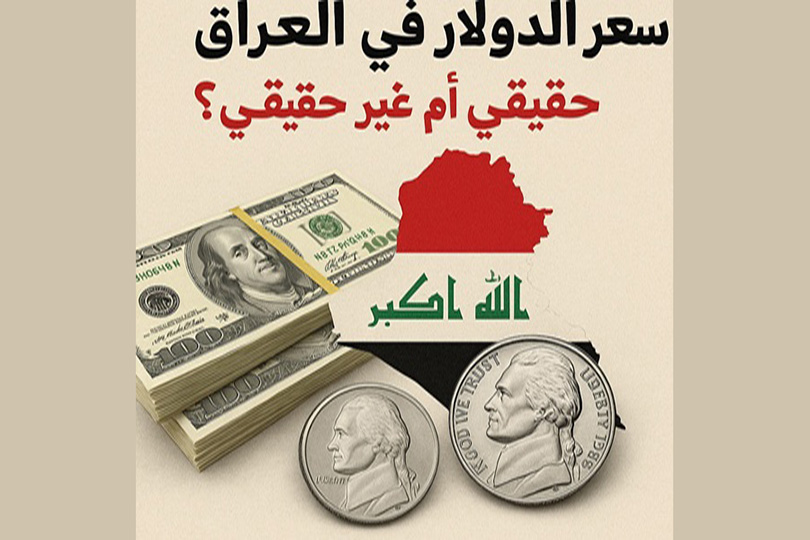Hamed Abdul-Hussein Al-Jubouri
The lack of clarity regarding the true exchange rate of the U.S. dollar in Iraq reflects the ongoing ambiguity of the country’s economic problems. Conversely, a precise analysis of the dollar exchange rate can help identify the root issues plaguing Iraq's economy and provide a basis for their resolution.
Where Does the Dollar Come From?
Iraq possesses vast oil reserves—over 145 billion barrels of proven reserves—and currently produces more than 4 million barrels per day, exporting over 3.25 million barrels daily. Globally, oil plays a crucial role across most economic sectors such as transportation, industry, and housing.
Since oil is priced in U.S. dollars worldwide—for various reasons including the dominance of the U.S. economy, the dollar’s wide use in international trade, and its significant share in global foreign reserves—this results in a continuous inflow of dollars into Iraq’s economy through the global oil market.
Why Is the Dollar in Demand?
Iraq’s domestic needs cannot be met using the Iraqi dinar alone, as the local currency lacks strong international acceptance due to the weakness of the underlying economy. The dollar, with its global acceptance, becomes essential for covering import costs and stabilizing the dinar's value.
How Does the Dollar Enter Iraq?
The Ministry of Oil, through its own companies and international contractors, produces and markets oil globally. Oil revenues, based on prevailing international market prices, are transferred by buyers to Iraq’s Ministry of Finance via the Central Bank of Iraq, through its account with the U.S. Federal Reserve. Upon request, the Federal Reserve releases dollar payments to Iraq.
The Journey of the Dollar Inside Iraq
After receiving dollar payments, the Central Bank of Iraq sells them domestically through the currency auction window. This process serves two main purposes:
Providing the Ministry of Finance with dinars to cover public expenditures.
Maintaining a balanced exchange rate—one of the central bank’s primary objectives.
The Ministry of Finance cannot directly finance expenditures in dollars, as doing so would conflict with the Central Bank's goal of upholding the sovereignty and stability of the Iraqi dinar.
The Role of the Central Bank
To manage the money supply and maintain economic stability, the Central Bank regulates the flow of dollars into the market. Since oil revenues are virtually the only source of foreign currency, and domestic demand is constantly rising, the bank must respond accordingly.
When demand for dollars increases, the exchange rate rises, and the value of the dinar falls. The Central Bank counters this by increasing the dollar supply to stabilize the dinar. Conversely, when the dollar supply is excessive, the bank reduces it to prevent the dinar from appreciating too much, as both depreciation and overvaluation can harm the economy.
The Weakness of Iraq’s Economy
Given that the dollar’s exchange rate is closely tied to oil revenues—which form the backbone of Iraq’s economy—it is evident that the general trend is a weakening dinar due to global shifts toward clean and renewable energy.
Iraq’s overdependence on oil—contributing 45–65% of GDP, over 85% of public revenue, and more than 98% of export earnings—explains why the Central Bank must intervene frequently to maintain currency stability. These statistics highlight the fragile and undiversified nature of Iraq’s economy, which cannot meet the growing needs of its population and must rely heavily on foreign economies.
This is clearly reflected in the consistent rise of both imports and dollar sales via the currency auction, indicating that Central Bank interventions are compensating for structural economic weaknesses.
Conclusion: Is the Exchange Rate Real?
The inability of Iraq’s economy to meet domestic demands, combined with the Central Bank’s regular interventions to defend the dinar, suggest that the exchange rate—whether the official 1,320 dinars per dollar or the parallel market rate of 1,470–1,500—is artificial rather than market-driven.
Without Central Bank support via the currency auction, the dollar’s value would soar, and the dinar would significantly depreciate, exposing the economy’s inability to generate sufficient dollar income on its own.
What Needs to Be Done?
To ensure a real and sustainable exchange rate, Iraq must address its economic vulnerabilities by reviving its productive and export sectors. This requires action on several key fronts:
Redefining the State’s Economic Role in line with post-2003 developments.
Empowering the Private Sector, which is more capable of innovation, competitiveness, and productivity.
Strengthening Institutional Governance to combat authoritarianism and corruption while revitalizing the economy.
Investing Oil Revenues in Infrastructure to create a business-friendly environment.
Raising Public Awareness through media campaigns that highlight the importance of preserving the dinar’s value and urging decision-makers to pursue economic reform.






Comments